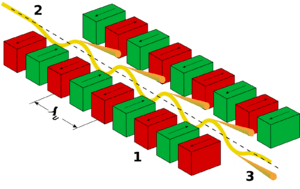Undulator facts for kids
An undulator is a special device used in big science machines called synchrotrons. Think of a synchrotron as a giant loop where tiny particles, like electrons, race around at super high speeds. An undulator is placed inside this loop. It's made of many strong magnets arranged in a pattern. These magnets create a changing magnetic field that makes the electrons wiggle or "undulate" as they pass through.
When electrons wiggle, they give off energy in the form of very bright and focused light, called synchrotron radiation. This light is super powerful and can be used for many different science experiments, from studying new materials to looking at tiny parts of living cells. The light from an undulator is much brighter and more focused than light from other parts of a synchrotron.
How Undulators Work Their Magic
The way an undulator makes light is quite clever. As the electrons fly through the undulator, the magnets push them back and forth. This makes the electrons follow a wavy path. Every time an electron changes direction, it releases a tiny burst of light. Because the magnets are arranged in a repeating pattern, all these tiny bursts of light add up perfectly. This creates a very strong and focused beam of light.
There's a special number, called the K-parameter, that helps scientists understand how the undulator works.
- If K is small, the electrons wiggle only a little bit. This makes the light very focused and bright, with specific colors (or energies). This is what a true undulator does.
- If K is large, the electrons wiggle a lot more. This makes the light spread out over many colors. When K is very large, the device is no longer called an undulator; it's called a wiggler. Wigglers also produce useful light, but it's different from an undulator's light.
Undulators are incredibly useful because they can make light that is hundreds of times brighter than other methods. This super bright light helps scientists see things in amazing detail. The light also comes out in a very narrow beam, like a laser pointer, which is great for precise experiments.
Controlling the Light
Scientists can even control the type of light that comes out of an undulator. By changing the way the magnets are set up, they can make the electrons wiggle in different ways.
- If the electrons wiggle in a flat line, the light will be linearly polarized. This means all the light waves are vibrating in the same direction.
- If the electrons wiggle in a spiral path, the light will be circularly polarized. This means the light waves are spinning as they travel.
This ability to control the light's properties makes undulators very flexible tools for many different types of research.
History
The idea for undulators was first thought of by the Russian physicist V.L. Ginzburg in 1947. However, the first actual undulator was built a few years later in 1953. It was created by Hans Motz and his team at Stanford. Their undulator was special because it produced the first-ever coherent infrared light. This means the light waves were all perfectly in sync, like a laser. Their device could make light ranging from visible colors all the way down to millimeter waves.
Undulators are now a key part of modern synchrotron facilities around the world, helping scientists make amazing discoveries.
See also
 In Spanish: Ondulador para niños
In Spanish: Ondulador para niños



